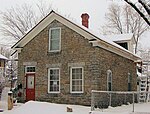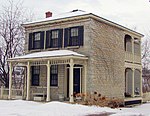United Hospital
1877 establishments in MinnesotaHospitals established in 1877Hospitals in Minnesota
United Hospital, located in St. Paul, Minnesota, is a 556-bed non-profit hospital that serves St. Paul and the eastern Twin Cities metropolitan area. United Hospital is part of Allina Health and offers specialty services including pregnancy care, birth center, behavioral health, cancer care, heart and vascular services, orthopedics and neuroscience. The hospital provides health care services to more than 200,000 people each year. United Hospital is the main hospital for the United Heart and Vascular Clinic.
Excerpt from the Wikipedia article United Hospital (License: CC BY-SA 3.0, Authors).United Hospital
Walnut Street Stairway, Saint Paul West Seventh - Fort Road
Geographical coordinates (GPS) Address Phone number Website External links Nearby Places Show on map
Geographical coordinates (GPS)
| Latitude | Longitude |
|---|---|
| N 44.94319 ° | E -93.10751 ° |
Address
United Hospital
Walnut Street Stairway 333
55102 Saint Paul, West Seventh - Fort Road
Minnesota, United States
Open on Google Maps









